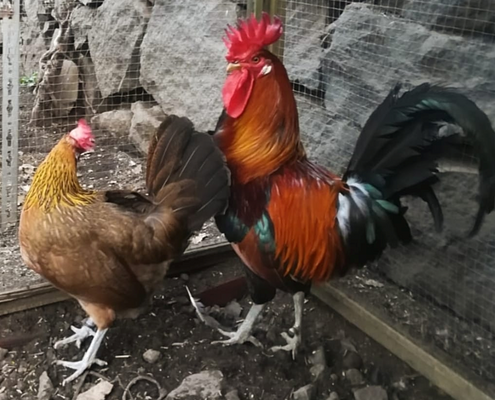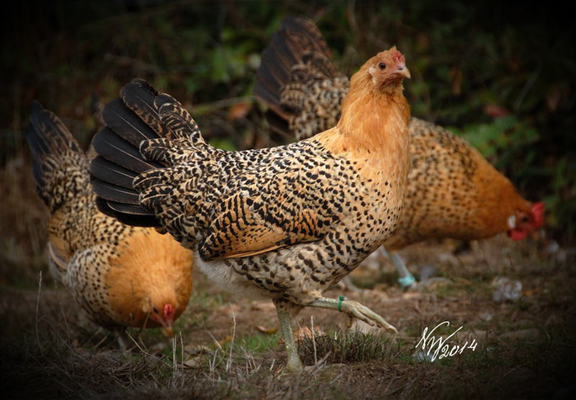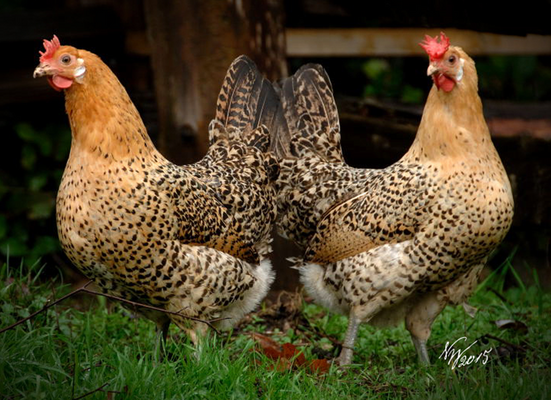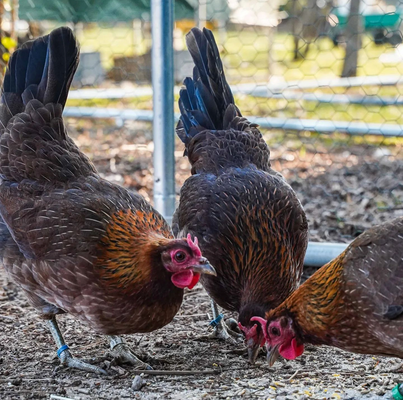Sicily is a rich source of ancient Mediterranean poultry genetics. Here’s a tour of the four native Sicilian breeds you’ll run into- Siciliana (Coronata), Cornuta di Caltanissetta, Nostrana delle Madonie, and Valplatani- plus their famous export cousin, the Sicilian Buttercup.
⸻
1) Siciliana (aka “Siciliana Coronata”)
What it is. The island’s classic crown-/“cup”-comb landrace from Sicily; formally in the Italian FIAV standard since 2004 and listed in Italy’s national register of autochthonous poultry by Ministerial Decree No. 1936 on October 1, 2014. Conservation status: recovering but still rare in numbers.
Where it comes from. Multi-generation notes and local lore describe a farm population shaped on Sicilian holdings, with long-ago mixing of local birds and North-African stock (“Tripolina”), which helps explain the crown comb and willow-green legs; 19th-century exports seeded overseas Buttercup lines. Modern keepers in Sicily maintain small flocks across coastal and inland farms.
Type & field marks.
• Head/comb: elegant, rounded head; crown/cup comb- fine texture; starts as single at the beak, forms a rounded cup (preferably closed) with ~5 regular “teeth” per side; bright red face/wattles; earlobes red, a small central white fleck sometimes seen.
• Body & carriage: medium, tidy trunk; broad rounded shoulders; long tight wings; tail fairly broad, carried high (≈70–75° cocks; ≈55–60° hens). Breast full, rounded, set fairly high.
• Legs/skin: bare, moderately long tarsi, typically willow-green; skin yellowish.
Colors.
• Collo Oro/Selvatico bruno/Perniciata → Gold Duckwing → Partridge Spectrum
• Nera → Black
• Bianca → White
• Blu → Blue
Comb & eggs. Cup/crown comb; shells white to very light cream. Pullets start ~5–6 months; organic-trial logs show ~190 eggs in the first year, with strong shells and mid-50s-gram “medium” weights (23.3 oz/dozen).
Size. Cocks ~2.0–2.4 kg = 4.4-5.3 lbs; hens ~1.6–1.8 kg = 3.5-4.0 lbs. Yellowish skin typical.
Behavior & management. Very rustic, lively, precocious; excellent free-range foragers; can be flighty in small runs. Do best with space and sun; suited to Mediterranean conditions and low-input farm routines.
Variation & outcross flags. Italian-type Siciliana shows red earlobes (a little white allowed), willow-green tarsi, and the distinct cup comb; persistent white earlobes with heavier bodies point to U.S. Sicilian Buttercup influence rather than core Italian type. Non-willow tarsi, feathered shanks, deeply tinted/brown eggs, or “squirrel tail” are faults and often signal outcrossing.
Duckwing/Partridge Types:


https://www.facebook.com/share/1ETnDB6GGk/?mibextid=wwXIfr

https://www.facebook.com/share/p/1AyQpHm3J3/?mibextid=wwXIfr

https://www.facebook.com/share/p/1NncST1xXR/?mibextid=wwXIfr

https://www.facebook.com/share/p/1JnbBQHQX6/?

https://www.facebook.com/share/p/1H2Yp5dEm1/?
Black/Blue/Splash:

https://www.facebook.com/share/p/19YRCUDfzY/?

https://www.facebook.com/share/p/16w3KBiHDu/?


https://www.facebook.com/share/p/19VeU2TZtF/?mibextid=wwXIfr
White:

https://gallinasiciliana.forumattivo.com/t1219-riproduttori-siciliana-bianca
Other Color:


https://www.facebook.com/share/p/1NFMz7rrAT/?mibextid=wwXIfr
⸻
2) Sicilian Buttercup (aka “Buttercup”)
What it is. The export cousin of Sicily’s crown-/“cup”-comb landrace, standardized abroad; admitted to the American Poultry Association Standard in 1918 (large fowl) and in 1960 (bantam). Still rare; conservation ongoing in the U.S./U.K.
Where it comes from. Club histories and old breeder notes trace U.S. lines to 19th-century imports- most modern stocks descending from hatchlings shipped in 1892 after earlier Dawes→Loring birds popularized the type. Breed clubs formed on both sides of the Atlantic by the 1910s.
Type & field marks.
• Head/comb: classic “buttercup” (cup/crown) comb- two combs joined in front (preferably also behind), with ~5 even points per side; white earlobes; bright red face/wattles.
• Body & carriage: medium, tidy trunk; wings long/tight; tail widely fanned and well spread at base; high carriage in cocks and hens.
• Legs/skin: bare tarsi; willow-green shanks/toes; yellow skin.
Colors.
• (U.S. standard) Golden → Golden (hens: golden-buff ground with fine, even black autosomal barring/spotting; cocks: rich orange-red body, black tail)
• (U.K./Australia/New Zealand) Silver Duckwing exists but is not APA-recognized in the U.S.
Comb & eggs. Cup/crown comb; shells white to very light cream. Typical first-year lay ~140–180 eggs; classed small–medium ≈50–55 g (22 oz/ dozen).
Size. Cocks ~2.9–3.0 kg = 6.4-6.6 lbs; hens ~2.3–2.5 kg = 5.1-5.5 lbs. (APA show weights ~6.5 lb cock, 5 lb hen.)
Behavior & management. Very active, alert foragers; dislike close confinement; best on range in warm, dry climates. Large combs are frostbite-prone; housing should be tall/airy.
Variation & outcross flags. U.S. type shows white earlobes and willow legs with the true cup comb; persistent red earlobes (more typical of Siciliana), non-willow legs, single/rose combs, or tinted/brown eggs point to outcrossing or non-APA lines. Note: earlobe color shifted to white in U.S. standards in the early 20th century; U.K. lines may show red.
Golden:

https://livestockconservancy.org/buttercup-chicken/

https://backyardpoultry.iamcountryside.com/chickens-101/raising-sicilian-buttercups-in-america/



https://www.americanbuttercupclub.org/about-the-breed.html



https://www.americanbuttercupclub.org/large-fowl.html

https://www.roysfarm.com/sicilian-buttercup-chicken/
Silver Duckwing:

https://www.feathersite.com/Poultry/CGA/BCup/BRKButtercup.html


https://www.rarebreeds.co.nz/sicilian.html
⸻
3) Cornuta di Caltanissetta (aka “Cornuta”)
What it is. A small, tough valley–hill landrace from the Caltanissetta (Nisseno) area, defined by a horned (“a corna di bue”) comb. Formal recognition in Italy was announced in April 2025; conservation remains active and local.
Where it comes from. Old family flocks in the Nisseno countryside- guarded and passed on within kin and trusted friends- are the source; older keepers recount that selling birds or eggs was taboo, which helped keep lines “in place.” TRS (Tutela Razze Siciliane) documented and stewarded the recovery; recent tallies mention a few hundred birds in and around Caltanissetta. Local legend links the “horns” to St. Michael and a duel with the devil- folklore that kept the type memorable.
Type & field marks.
• Head/comb: medium, fairly deep head; red face; earlobes red (a small central white fleck sometimes seen); true horned comb with two forward bull-horns, well set, never swept back. Eyes red-brown.
• Body & carriage: country build; moderately long trunk; long, tight wings; tail broad and high (often >60°), long sickles in cocks.
• Legs/skin: bare tarsi, typically willow-green; skin “morata”/dusky rather than yellow. Occasional keeper notes of double spurs in cocks.
Colors.
• Collo Oro/Selvatico bruno/Perniciata → Gold Duckwing + Partridge Spectrum
• Selvatico bruno macchiettata → Mottled Duckwing
Expect shade variation across farms; many hens show a dark “testa di moro” head.
Comb & eggs. Horned (bull-horn) comb; shells white. Proposed standard lists a 45 g minimum egg weight (19 oz/ dozen); lines are described as non-broody with good lay for a heritage landrace.
Size. Cocks ~1.6–2.0 kg = 3.5-4.4 lbs; hens ~1.1–1.8 kg = 2.4-4 lbs. Skin typically dusky; willow legs usual.
Behavior & management. Very rustic, lively, disease-resistant; strong free-range foragers and adaptable on sun-exposed Sicilian holdings. Keepers describe them as surprisingly tame compared with other local landraces when regularly handled.
Variation & outcross flags. Core type shows red earlobes (only a small white fleck allowed), willow-green tarsi, dusky skin, and the forward horned comb. Persistent white earlobes, yellow skin, feathered legs, single/rose/cup combs, or solid non-wild-type colors (e.g., full black/white) point to outcrosses (e.g., show strains or other horn-combed breeds).
Duckwing/Partridge Types:

https://www.tuttosullegalline.it/razze-galline/cornuta-di-caltanissetta/amp/



https://www.facebook.com/share/1DATYVuzzC/?mibextid=wwXIfr

https://www.facebook.com/share/p/19d271wLDu/?


https://www.facebook.com/share/p/1C5ZfKvTn3/?

https://www.facebook.com/share/p/17ZrZ1kx3G/?


https://www.facebook.com/share/p/1Jxf9dJkUi/?

https://www.facebook.com/share/p/1732dHABhQ/?
Mottled Duckwing:

https://www.facebook.com/share/p/14GvEPRNR7k/?

https://www.facebook.com/share/p/16DdM89wrT/?

https://www.facebook.com/share/p/19pFMrqjwi/?
⸻
1) Siciliana (aka “Siciliana Coronata”)
What it is. The island’s classic crown-/“cup”-comb landrace from Sicily; formally in the Italian FIAV standard since 2004 and listed in Italy’s national register of autochthonous poultry by Ministerial Decree No. 1936 on October 1, 2014. Conservation status: recovering but still rare in numbers.
Where it comes from. Multi-generation notes and local lore describe a farm population shaped on Sicilian holdings, with long-ago mixing of local birds and North-African stock (“Tripolina”), which helps explain the crown comb and willow-green legs; 19th-century exports seeded overseas Buttercup lines. Modern keepers in Sicily maintain small flocks across coastal and inland farms.
Type & field marks.
• Head/comb: elegant, rounded head; crown/cup comb- fine texture; starts as single at the beak, forms a rounded cup (preferably closed) with ~5 regular “teeth” per side; bright red face/wattles; earlobes red, a small central white fleck sometimes seen.
• Body & carriage: medium, tidy trunk; broad rounded shoulders; long tight wings; tail fairly broad, carried high (≈70–75° cocks; ≈55–60° hens). Breast full, rounded, set fairly high.
• Legs/skin: bare, moderately long tarsi, typically willow-green; skin yellowish.
Colors.
• Collo Oro/Selvatico bruno/Perniciata → Gold Duckwing → Partridge Spectrum
• Nera → Black
• Bianca → White
• Blu → Blue
Comb & eggs. Cup/crown comb; shells white to very light cream. Pullets start ~5–6 months; organic-trial logs show ~190 eggs in the first year, with strong shells and mid-50s-gram “medium” weights (23.3 oz/dozen).
Size. Cocks ~2.0–2.4 kg = 4.4-5.3 lbs; hens ~1.6–1.8 kg = 3.5-4.0 lbs. Yellowish skin typical.
Behavior & management. Very rustic, lively, precocious; excellent free-range foragers; can be flighty in small runs. Do best with space and sun; suited to Mediterranean conditions and low-input farm routines.
Variation & outcross flags. Italian-type Siciliana shows red earlobes (a little white allowed), willow-green tarsi, and the distinct cup comb; persistent white earlobes with heavier bodies point to U.S. Sicilian Buttercup influence rather than core Italian type. Non-willow tarsi, feathered shanks, deeply tinted/brown eggs, or “squirrel tail” are faults and often signal outcrossing.
Duckwing/Partridge Types:
https://www.facebook.com/share/1ETnDB6GGk/?mibextid=wwXIfr
https://www.facebook.com/share/p/1AyQpHm3J3/?mibextid=wwXIfr
https://www.facebook.com/share/p/1NncST1xXR/?mibextid=wwXIfr
https://www.facebook.com/share/p/1JnbBQHQX6/?
https://www.facebook.com/share/p/1H2Yp5dEm1/?
Black/Blue/Splash:
https://www.facebook.com/share/p/19YRCUDfzY/?
https://www.facebook.com/share/p/16w3KBiHDu/?
https://www.facebook.com/share/p/19VeU2TZtF/?mibextid=wwXIfr
White:
https://gallinasiciliana.forumattivo.com/t1219-riproduttori-siciliana-bianca
Other Color:
https://www.facebook.com/share/p/1NFMz7rrAT/?mibextid=wwXIfr
⸻
2) Sicilian Buttercup (aka “Buttercup”)
What it is. The export cousin of Sicily’s crown-/“cup”-comb landrace, standardized abroad; admitted to the American Poultry Association Standard in 1918 (large fowl) and in 1960 (bantam). Still rare; conservation ongoing in the U.S./U.K.
Where it comes from. Club histories and old breeder notes trace U.S. lines to 19th-century imports- most modern stocks descending from hatchlings shipped in 1892 after earlier Dawes→Loring birds popularized the type. Breed clubs formed on both sides of the Atlantic by the 1910s.
Type & field marks.
• Head/comb: classic “buttercup” (cup/crown) comb- two combs joined in front (preferably also behind), with ~5 even points per side; white earlobes; bright red face/wattles.
• Body & carriage: medium, tidy trunk; wings long/tight; tail widely fanned and well spread at base; high carriage in cocks and hens.
• Legs/skin: bare tarsi; willow-green shanks/toes; yellow skin.
Colors.
• (U.S. standard) Golden → Golden (hens: golden-buff ground with fine, even black autosomal barring/spotting; cocks: rich orange-red body, black tail)
• (U.K./Australia/New Zealand) Silver Duckwing exists but is not APA-recognized in the U.S.
Comb & eggs. Cup/crown comb; shells white to very light cream. Typical first-year lay ~140–180 eggs; classed small–medium ≈50–55 g (22 oz/ dozen).
Size. Cocks ~2.9–3.0 kg = 6.4-6.6 lbs; hens ~2.3–2.5 kg = 5.1-5.5 lbs. (APA show weights ~6.5 lb cock, 5 lb hen.)
Behavior & management. Very active, alert foragers; dislike close confinement; best on range in warm, dry climates. Large combs are frostbite-prone; housing should be tall/airy.
Variation & outcross flags. U.S. type shows white earlobes and willow legs with the true cup comb; persistent red earlobes (more typical of Siciliana), non-willow legs, single/rose combs, or tinted/brown eggs point to outcrossing or non-APA lines. Note: earlobe color shifted to white in U.S. standards in the early 20th century; U.K. lines may show red.
Golden:
https://livestockconservancy.org/buttercup-chicken/
https://backyardpoultry.iamcountryside.com/chickens-101/raising-sicilian-buttercups-in-america/
https://www.americanbuttercupclub.org/about-the-breed.html
https://www.americanbuttercupclub.org/large-fowl.html
https://www.roysfarm.com/sicilian-buttercup-chicken/
Silver Duckwing:
https://www.feathersite.com/Poultry/CGA/BCup/BRKButtercup.html
https://www.rarebreeds.co.nz/sicilian.html
⸻
3) Cornuta di Caltanissetta (aka “Cornuta”)
What it is. A small, tough valley–hill landrace from the Caltanissetta (Nisseno) area, defined by a horned (“a corna di bue”) comb. Formal recognition in Italy was announced in April 2025; conservation remains active and local.
Where it comes from. Old family flocks in the Nisseno countryside- guarded and passed on within kin and trusted friends- are the source; older keepers recount that selling birds or eggs was taboo, which helped keep lines “in place.” TRS (Tutela Razze Siciliane) documented and stewarded the recovery; recent tallies mention a few hundred birds in and around Caltanissetta. Local legend links the “horns” to St. Michael and a duel with the devil- folklore that kept the type memorable.
Type & field marks.
• Head/comb: medium, fairly deep head; red face; earlobes red (a small central white fleck sometimes seen); true horned comb with two forward bull-horns, well set, never swept back. Eyes red-brown.
• Body & carriage: country build; moderately long trunk; long, tight wings; tail broad and high (often >60°), long sickles in cocks.
• Legs/skin: bare tarsi, typically willow-green; skin “morata”/dusky rather than yellow. Occasional keeper notes of double spurs in cocks.
Colors.
• Collo Oro/Selvatico bruno/Perniciata → Gold Duckwing + Partridge Spectrum
• Selvatico bruno macchiettata → Mottled Duckwing
Expect shade variation across farms; many hens show a dark “testa di moro” head.
Comb & eggs. Horned (bull-horn) comb; shells white. Proposed standard lists a 45 g minimum egg weight (19 oz/ dozen); lines are described as non-broody with good lay for a heritage landrace.
Size. Cocks ~1.6–2.0 kg = 3.5-4.4 lbs; hens ~1.1–1.8 kg = 2.4-4 lbs. Skin typically dusky; willow legs usual.
Behavior & management. Very rustic, lively, disease-resistant; strong free-range foragers and adaptable on sun-exposed Sicilian holdings. Keepers describe them as surprisingly tame compared with other local landraces when regularly handled.
Variation & outcross flags. Core type shows red earlobes (only a small white fleck allowed), willow-green tarsi, dusky skin, and the forward horned comb. Persistent white earlobes, yellow skin, feathered legs, single/rose/cup combs, or solid non-wild-type colors (e.g., full black/white) point to outcrosses (e.g., show strains or other horn-combed breeds).
Duckwing/Partridge Types:
https://www.tuttosullegalline.it/razze-galline/cornuta-di-caltanissetta/amp/
https://www.facebook.com/share/1DATYVuzzC/?mibextid=wwXIfr
https://www.facebook.com/share/p/19d271wLDu/?
https://www.facebook.com/share/p/1C5ZfKvTn3/?
https://www.facebook.com/share/p/17ZrZ1kx3G/?
https://www.facebook.com/share/p/1Jxf9dJkUi/?
https://www.facebook.com/share/p/1732dHABhQ/?
Mottled Duckwing:
https://www.facebook.com/share/p/14GvEPRNR7k/?
https://www.facebook.com/share/p/16DdM89wrT/?
https://www.facebook.com/share/p/19pFMrqjwi/?
Attachments
Last edited:







